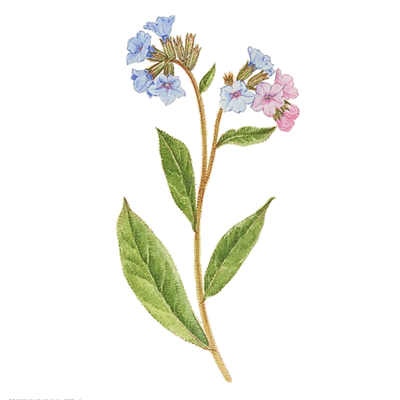![]()

![]()

Flowering early and long, with foliage to rival many of the more famous variegated plants, pulmonarias are well worth a place in the garden. But how did the pulmonaria get its name. The botanical name of the wild species - Pulmonaria officinalis - gives us a clue. 'Officinalis' means 'medicinal' or 'of the pharmacopoeia'. This suggests that the plant was being used as a medicine before it was given its botanical name by Linnaeus. So what was its common name. In fact, it has several - Jerusalem sage, Bethlehem sage, Spotted dog (from the spotted leaves), Soldiers and sailors (from the way the flowers of many of the species and cultivars which have pink buds opening to pink or red, gradually changing to blue as they mature or fade), and - wait for it - Lungwort, a plant good for the lungs. Herbals indicate that this plant is useful for lung diseases, the blotched lung-shaped leaves (which looked like what people thought diseased lungs did look like), under the Doctrine of Signatures, suggested this application. Unfortunately, there is little evidence of the Lungworts capacity for healing such complaints. It may be of interest (and then again it may not) that the French common name means 'Lung plant', and the German one means 'Real lung herb', so the connection with the lungs is not just confined to this country.
The Lungwort is found in just about every mainland country in Europe, but not in any of the islands, such as Corsica and Crete, the Azores, Majorca, Minorca, Sardinia and Sicily. This, I am sure must tell us something about the plant, if only that it can't swim.
Until 20 years ago these lowly plants were available to gardeners in only a few species and varieties, but, like a lot of other plants, they are quite promiscuous, and interbreed and seed themselves quite freely. A great many more garden-worthy forms have been selected and introduced, and there must be at least fifty cultivars available.
Pulmonarias have a lot to offer gardeners. They flower early, usually starting in early March, and go on flowering for quite a long time. They are clump-forming, so they don't run rampant through the border like some plants do. They usually have rough or hairy leaves, and some, though not all, have white or silver spots on them, so they are useful as a foliage plant and as ground cover in sun or shade (even beneath deciduous trees or shrubs) provided the soil is not too dry.
Because of the low-growing, early-flowering habit of pulmonarias it is an ideal plant for the back of the border. There, it can show itself in all its glory for several weeks in early spring, but then, later in the season, as its show fades, it is hidden from view by taller, summer flowering perennials. This is particularly recommended for varieties with plain green leaves which do not have the variegated leaves to show off. But don't let this stop you from putting them in the front of the border with both spring and summer flowering perennials. They look charming and natural planted between evergreen and deciduous shrubs and beneath deciduous trees. Many newer selections, which have highly ornamental, splashed and spotted leaves, make such good foliage plants that they deserve prominent position. Indeed these varieties associate so well in summer and autumn with other plants, shrubs, conifers and perennials that to put them out of sight at the back of a border would be a waste. In fact some pulmonarias are as effective as hostas when it comes to foliage effect. And they have the added advantage of not being eaten by every passing slug and snail. They can also be used as specimen plants dotted about singly in shady, bare patches against north-facing walls or between evergreen shrubs.
Generally, pulmonarias are a trouble-free group of perennials, though some are prone to mildew in late summer. They have fleshy roots and, while they last for years without disturbance, they can get old and woody in the centre of the clump. This reduces the effectiveness of both flowers and foliage, and consequently they are best divided every few years. The ideal time to divide them is in late August or September while there is still time for new roots to take hold. A few new leaves will also appear. As usual when dividing herbaceous plants, throw away any very old woody pieces, and replant only those parts with younger shoots and roots which are to be found on the outside of the clumps. Water in well and you will have a sturdy flowering plant by the following spring. There is such a variety of pulmonarias available today, plain and variegated leaves that I hesitate to suggest any particular one. It is a case of 'You pay your money and you take your pick'.
April is upon us once more (whatever happened to 1996?). June will soon be here, and with it the Church Summer Fête. So, once again, I am asking if anyone out there has some flower pots they do not want. Last year we sold over one hundred plants, which will give you some idea of the scale of the problem. And I do need time to scrub the pots, sterilise them, and get the plants settled into the pots by the middle of May at the latest to give them a chance to recover from the ordeal. If anybody has any, I can always be found in the Church hall after the Eucharist on Sunday morning or at the back of the church after Evensong.
Happy gardening.
Garden Gossip written by Bill Hutchings
![]() return to the April 1997 features page
return to the April 1997 features page
![]() return to Home page and main index
return to Home page and main index
page last updated 30 MARCH 1997